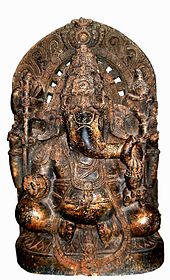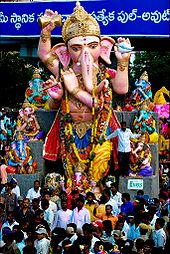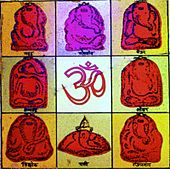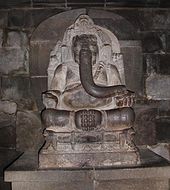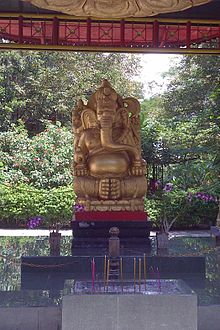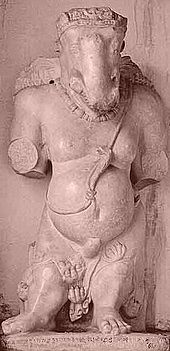|
|
Classification |
| Devanagari | no_data |
| Sanskrit Transliteration | no_data |
| Affiliation | no_data |
| Abode | no_data |
| Mantra | no_data |
| Weapon | no_data |
| Consort | no_data |
| Children | no_data |
| Mount | no_data |
| Ganesha |
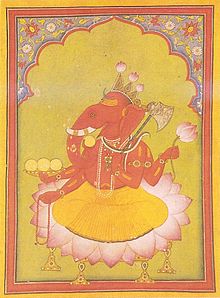
Ganesha has the head of an elephant and the body of a Siddha. |
| Devanagari |
गणेश |
| Sanskrit Transliteration |
GaneSa |
| Affiliation |
Deva |
| Mantra |
Oṃ GaneSaya Namaḥ |
| Weapon |
ParaSu (Axe), paSa (Snare) , aṅkuSa (Elephant hook) |
| Consort |
Buddhi (wisdom), Riddhi (prosperity), Siddhi (attainment) |
| Mount |
Mouse |
Ganesha (IAST: GaneSa;  listen (help·info)), also spelled Ganesa, also known as Ganapati and Vinayaka is a widely worshipped deity in the Hindu pantheon. His image is found throughout India and Nepal. Hindu sects worship him regardless of affiliations. Devotion to Ganesha is widely diffused and extends to Jains, Buddhists, and beyond India. listen (help·info)), also spelled Ganesa, also known as Ganapati and Vinayaka is a widely worshipped deity in the Hindu pantheon. His image is found throughout India and Nepal. Hindu sects worship him regardless of affiliations. Devotion to Ganesha is widely diffused and extends to Jains, Buddhists, and beyond India.
Although he is known by many attributes, Ganesha's elephant head makes him easy to identify. Ganesha is widely revered as the remover of obstacles, the patron of arts and sciences and the deva of intellect and wisdom. As the god of beginnings, he is honoured at the start of rituals and ceremonies. Ganesha is also invoked as patron of letters and learning during writing sessions. Several texts relate mythological anecdotes associated with his birth and exploits and explain his distinct iconography.
Ganesha emerged as a distinct deity in the 4th and 5th centuries CE, during the Gupta Period, although he inherited traits from Vedic and pre-Vedic precursors. He was formally included among the five primary deities of Smartism (a Hindu denomination) in the 9th century. A sect of devotees called the Ganapatya arose, who identified Ganesha as the supreme deity. The principal scriptures dedicated to Ganesha are the Ganesha Purana, the Mudgala Purana, and the Ganapati Atharvashirsa.
Etymology and other names
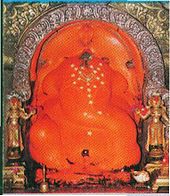
Ganesha as 'Shri Mayureshwar' with consorts Buddhi and Siddhi, Morgaon (the central shrine for the regional Ashtavinayak complex)
Ganesha has been ascribed many other titles and epithets, including Ganapati and Vighneshvara. The Hindu title of respect Shri (Sanskrit: श्री; IAST: Sri; also spelled Sri or Shree) is often added before his name. One popular way Ganesha is worshipped is by chanting a Ganesha Sahasranama, a litany of "a thousand names of Ganesha". Each name in the sahasranama conveys a different meaning and symbolises a different aspect of Ganesha. At least two different versions of the Ganesha Sahasranama exist; one version is drawn from the Ganesha Purana, a Hindu scripture venerating Ganesha.
The name Ganesha is a Sanskrit compound, joining the words gana (Sanskrit: गण; IAST: gana), meaning a group, multitude, or categorical system and isha (Sanskrit: ईश; IAST: iSa), meaning lord or master. The word gana when associated with Ganesha is often taken to refer to the ganas, a troop of semi-divine beings that form part of the retinue of Shiva (IAST: Siva). The term more generally means a category, class, community, association, or corporation. Some commentators interpret the name "Lord of the Ganas" to mean "Lord of Hosts" or "Lord of created categories", such as the elements. Ganapati (Sanskrit: गणपति; IAST: ganapati), a synonym for Ganesha, is a compound composed of gana, meaning "group", and pati, meaning "ruler" or "lord". The Amarakosha, an early Sanskrit lexicon, lists eight synonyms of Ganesha : Vinayaka, Vighnaraja (equivalent to Vighnesha), Dvaimatura (one who has two mothers), Ganadhipa (equivalent to Ganapati and Ganesha), Ekadanta (one who has one tusk), Heramba, Lambodara (one who has a pot belly, or, literally, one who has a hanging belly), and Gajanana (IAST: gajanana); having the face of an elephant).
Vinayaka (Sanskrit: विनायक; IAST: vinayaka) is a common name for Ganesha that appears in the Puranas and in Buddhist Tantras. This name is reflected in the naming of the eight famous Ganesha temples in Maharashtra known as the Ashtavinayak (ashtavinayaka). The names Vighnesha (Sanskrit: विघ्नेश; IAST: vighneSa) and Vighneshvara (विघ्नेश्वर; vighneSvara) (Lord of Obstacles) refers to his primary function in Hindu theology as the master and remover of obstacles (vighna).
A prominent name for Ganesha in the Tamil language is Pillai (Tamil: பிள்ளை) or Pillaiyaar (பிள்ளையார்) (Little Child). A. K. Narain differentiates these terms by saying that pillai means a "child" while pillaiyar means a "noble child". He adds that the words pallu, pella, and pell in the Dravidian family of languages signify "tooth or tusk", also "elephant tooth or tusk". Anita Raina Thapan notes that the root word pille in the name Pillaiyar might have originally meant "the young of the elephant", because the Pali word pillaka means "a young elephant".
In the Burmese language, Ganesha is known as Maha Peinne (မဟာပိန္နဲ, pronounced: [məhà pèiɴné]), derived from Pali Maha Winayaka(မဟာဝိနာယက). The widespread name of Ganesha in Thailand is Phra Phikhanet or Phra Phikhanesuan, both of which are derived from Vara Vighnesha and Vara Vighneshvara respectively, whereas the name Khanet (from Ganesha) is rather rare.
In Sri Lanka in the North-Central and North Western areas with pre dominantly Buddhist population, Ganesha is known as Aiyanayaka Deviyo while in other Singhala buddhist areas he is known as Gana deviyo.
Iconography
Ganesha is a popular figure in Indian art. Unlike those of some deities, representations of Ganesha show wide variations and distinct patterns changing over time. He may be portrayed standing, dancing, heroically taking action against demons, playing with his family as a boy, sitting down or on an elevated seat, or engaging in a range of contemporary situations.
Ganesha images were prevalent in many parts of India by the 6th century. The 13th century statue pictured is typical of Ganesha statuary from 900–1200, after Ganesha had been well-established as an independent deity with his own sect. This example features some of Ganesha's common iconographic elements. A virtually identical statue has been dated between 973–1200 by Paul Martin-Dubost, and another similar statue is dated c. 12th century by Pratapaditya Pal. Ganesha has the head of an elephant and a big belly. This statue has four arms, which is common in depictions of Ganesha. He holds his own broken tusk in his lower-right hand and holds a delicacy, which he samples with his trunk, in his lower-left hand. The motif of Ganesha turning his trunk sharply to his left to taste a sweet in his lower-left hand is a particularly archaic feature. A more primitive statue in one of the Ellora Caves with this general form has been dated to the 7th century. Details of the other hands are difficult to make out on the statue shown. In the standard configuration, Ganesha typically holds an axe or a goad in one upper arm and a noose in the other upper arm.
The influence of this old constellation of iconographic elements can still be seen in contemporary representations of Ganesha. In one modern form, the only variation from these old elements is that the lower-right hand does not hold the broken tusk but is turned towards the viewer in a gesture of protection or fearlessness (abhaya mudra). The same combination of four arms and attributes occurs in statues of Ganesha dancing, which is a very popular theme.
Common attributes
- For thirty-two popular iconographic forms of Ganesha, see Sritattvanidhi
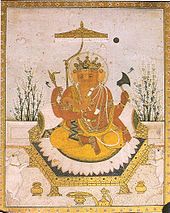
A typical four-armed form. Miniature of Nurpur school (circa 1810)
Ganesha has been represented with the head of an elephant since the early stages of his appearance in Indian art. Puranic myths provide many explanations for how he got his elephant head. One of his popular forms, Heramba-Ganapati, has five elephant heads, and other less-common variations in the number of heads are known. While some texts say that Ganesha was born with an elephant head, he acquires the head later in most stories . The most recurrent motif in these stories is that Ganesha was created by Parvati using clay to protect her and Shiva beheaded him when Ganesha came between Shiva and Parvati. Shiva then replaced Ganesha's original head with that of an elephant. Details of the battle and where the replacement head came from vary from source to source. Another story says that Ganesha was created directly by Shiva's laughter. Because Shiva considered Ganesha too alluring, he gave him the head of an elephant and a protruding belly.
Ganesha's earliest name was Ekadanta (One Tusked), referring to his single whole tusk, the other being broken. Some of the earliest images of Ganesha show him holding his broken tusk. The importance of this distinctive feature is reflected in the Mudgala Purana, which states that the name of Ganesha's second incarnation is Ekadanta. Ganesha's protruding belly appears as a distinctive attribute in his earliest statuary, which dates to the Gupta period (4th to 6th centuries). This feature is so important that, according to the Mudgala Purana, two different incarnations of Ganesha use names based on it: Lambodara (Pot Belly, or, literally, Hanging Belly) and Mahodara (Great Belly). Both names are Sanskrit compounds describing his belly (IAST: udara). The Brahmanda Purana says that Ganesha has the name Lambodara because all the universes (i.e., cosmic eggs; IAST: Brahmanḍas) of the past, present, and future are present in him. The number of Ganesha's arms varies; his best-known forms have between two and sixteen arms. Many depictions of Ganesha feature four arms, which is mentioned in Puranic sources and codified as a standard form in some iconographic texts. His earliest images had two arms. Forms with 14 and 20 arms appeared in Central India during the 9th and the 10th centuries. The serpent is a common feature in Ganesha iconography and appears in many forms. According to the Ganesha Purana, Ganesha wrapped the serpent Vasuki around his neck. Other depictions of snakes include use as a sacred thread (IAST: yajñyopavita) wrapped around the stomach as a belt, held in a hand, coiled at the ankles, or as a throne. Upon Ganesha's forehead may be a third eye or the Shaivite sectarian mark (IAST: tilaka), which consists of three horizontal lines. The Ganesha Purana prescribes a tilaka mark as well as a crescent moon on the forehead. A distinct form of Ganesha called Bhalachandra (IAST: bhalacandra; "Moon on the Forehead") includes that iconographic element. Ganesha is often described as red in color. Specific colors are associated with certain forms. Many examples of color associations with specific meditation forms are prescribed in the Sritattvanidhi, a treatise on Hindu iconography. For example, white is associated with his representations as Heramba-Ganapati and Rina-Mochana-Ganapati (Ganapati Who Releases from Bondage). Ekadanta-Ganapati is visualized as blue during meditation in that form.
Vahanas
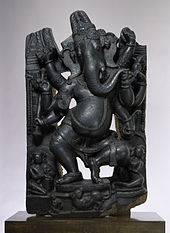
Ganesha's dancing and love of sweets are represented. The mouse is depicted at the base. The Walters Art Museum.
The earliest Ganesha images are without a vahana (mount/vehicle). Of the eight incarnations of Ganesha described in the Mudgala Purana, Ganesha uses a mouse (shrew) in five of them, a lion in his incarnation as Vakratunda, a peacock in his incarnation as Vikata, and Shesha, the divine serpent, in his incarnation as Vighnaraja. Mohotkata uses a lion, MayūreSvara uses a peacock, Dhumraketu uses a horse, and Gajanana uses a mouse, in the four incarnations of Ganesha listed in the Ganesha Purana. Jain depictions of Ganesha show his vahana variously as a mouse, elephant, tortoise, ram, or peacock.
Ganesha is often shown riding on or attended by a mouse, shrew or rat. Martin-Dubost says that the rat began to appear as the principal vehicle in sculptures of Ganesha in central and western India during the 7th century; the rat was always placed close to his feet. The mouse as a mount first appears in written sources in the Matsya Purana and later in the Brahmananda Purana and Ganesha Purana, where Ganesha uses it as his vehicle in his last incarnation. The Ganapati Atharvashirsa includes a meditation verse on Ganesha that describes the mouse appearing on his flag. The names Mūshakavahana (mouse-mount) and akhuketana (rat-banner) appear in the Ganesha Sahasranama.
The mouse is interpreted in several ways. According to Grimes, "Many, if not most of those who interpret Ganapati's mouse, do so negatively; it symbolizes tamoguna as well as desire". Along these lines, Michael Wilcockson says it symbolizes those who wish to overcome desires and be less selfish. Krishan notes that the rat is destructive and a menace to crops. The Sanskrit word mūshaka (mouse) is derived from the root mūsh (stealing, robbing). It was essential to subdue the rat as a destructive pest, a type of vighna (impediment) that needed to be overcome. According to this theory, showing Ganesha as master of the rat demonstrates his function as Vigneshvara (Lord of Obstacles) and gives evidence of his possible role as a folk grama-devata (village deity) who later rose to greater prominence. Martin-Dubost notes a view that the rat is a symbol suggesting that Ganesha, like the rat, penetrates even the most secret places.
Associations
Obstacles
Ganesha is Vighneshvara or Vighnaraja or "Vighnaharta"(marathi), the Lord of Obstacles, both of a material and spiritual order. He is popularly worshipped as a remover of obstacles, though traditionally he also places obstacles in the path of those who need to be checked. Paul Courtright says that "his task in the divine scheme of things, his dharma, is to place and remove obstacles. It is his particular territory, the reason for his creation."
Krishan notes that some of Ganesha's names reflect shadings of multiple roles that have evolved over time. Dhavalikar ascribes the quick ascension of Ganesha in the Hindu pantheon, and the emergence of the Ganapatyas, to this shift in emphasis from vighnakarta (obstacle-creator) to vighnaharta (obstacle-averter). However, both functions continue to be vital to his character.
Buddhi (Knowledge)
Ganesha is considered to be the Lord of letters and learning. In Sanskrit, the word buddhi is a feminine noun that is variously translated as intelligence, wisdom, or intellect. The concept of buddhi is closely associated with the personality of Ganesha, especially in the Puranic period, when many stories stress his cleverness and love of intelligence. One of Ganesha's names in the Ganesha Purana and the Ganesha Sahasranama is Buddhipriya. This name also appears in a list of 21 names at the end of the Ganesha Sahasranama that Ganesha says are especially important. The word priya can mean "fond of", and in a marital context it can mean "lover" or "husband", so the name may mean either "Fond of Intelligence" or "Buddhi's Husband".
Aum
Ganesha is identified with the Hindu mantra Aum (Telugu:ఓం, Tamil:ஓம், Sanskrit:ॐ) also spelled Om). The term oṃkarasvarūpa (Aum is his form), when identified with Ganesha, refers to the notion that he personifies the primal sound. The Ganapati Atharvashirsa attests to this association. Chinmayananda translates the relevant passage as follows:
(O Lord Ganapati!) You are (the Trinity) Brahma, Vishnu, and Mahesa. You are Indra. You are fire [Agni] and air [Vayu]. You are the sun [Sūrya] and the moon [Chandrama]. You are Brahman. You are (the three worlds) Bhuloka [earth], Antariksha-loka [space], and Swargaloka [heaven]. You are Om. (That is to say, You are all this).
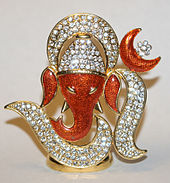
Ganesha (Devanagari) Aum jewel
Some devotees see similarities between the shape of Ganesha's body in iconography and the shape of Aum in the Devanagari and Tamil scripts.
First chakra
According to Kundalini yoga, Ganesha resides in the first chakra, called Muladhara (mūladhara). Mula means "original, main"; adhara means "base, foundation". The muladhara chakra is the principle on which the manifestation or outward expansion of primordial Divine Force rests. This association is also attested to in the Ganapati Atharvashirsa. Courtright translates this passage as follows: "[O Ganesha,] You continually dwell in the sacral plexus at the base of the spine [mūladhara cakra]." Thus, Ganesha has a permanent abode in every being at the Muladhara. Ganesha holds, supports and guides all other chakras, thereby "governing the forces that propel the wheel of life".
Family and consorts
Though Ganesha is popularly held to be the son of Shiva and Parvati, the Puranic myths give different versions about his birth. He may have been created by Parvati, or by Shiva and Parvati, or may have appeared mysteriously and was discovered by Shiva and Parvati.
The family includes his brother the war god Kartikeya, who is also called Subramanya, Skanda, Murugan and other names. Regional differences dictate the order of their births. In northern India, Skanda is generally said to be the elder, while in the south, Ganesha is considered the first born. In northern India, Skanda was an important martial deity from about 500 BCE to about 600 CE, when worship of him declined significantly in northern India. As Skanda fell, Ganesha rose. Several stories tell of sibling rivalry between the brothers and may reflect sectarian tensions.
Ganesha's marital status, the subject of considerable scholarly review, varies widely in mythological stories. One pattern of myths identifies Ganesha as an unmarried brahmacari. This view is common in southern India and parts of northern India. Another pattern associates him with the concepts of Buddhi (intellect), Siddhi (spiritual power), and Riddhi (prosperity); these qualities are sometimes personified as goddesses, said to be Ganesha's wives. He also may be shown with a single consort or a nameless servant (Sanskrit: daşi). Another pattern connects Ganesha with the goddess of culture and the arts, Sarasvati or Sarda (particularly in Maharashtra). He is also associated with the goddess of luck and prosperity, Lakshmi. Another pattern, mainly prevalent in the Bengal region, links Ganesha with the banana tree, Kala Bo.
The Shiva Purana says that Ganesha had begotten two sons: Kşema (prosperity) and Labha (profit). In northern Indian variants of this story, the sons are often said to be Subha (auspiciouness) and Labha. The 1975 Hindi film Jai Santoshi Maa shows Ganesha married to Riddhi and Siddhi and having a daughter named Santoshi Ma, the goddess of satisfaction. This story has no Puranic basis, but Anita Raina Thapan and Lawrence Cohen cite Santoshi Ma's cult as evidence of Ganesha's continuing evolution as a popular deity.
Worship and festivals
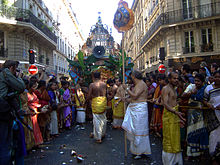
Celebrations of Ganesh by the Tamil community in Paris, France
Ganesha is worshipped on many religious and secular occasions; especially at the beginning of ventures such as buying a vehicle or starting a business. K.N. Somayaji says, "there can hardly be a [Hindu] home [in India] which does not house an idol of Ganapati. [..] Ganapati, being the most popular deity in India, is worshipped by almost all castes and in all parts of the country". Devotees believe that if Ganesha is propitiated, he grants success, prosperity and protection against adversity.
Ganesha is a non-sectarian deity, and Hindus of all denominations invoke him at the beginning of prayers, important undertakings, and religious ceremonies. Dancers and musicians, particularly in southern India, begin performances of arts such as the Bharatnatyam dance with a prayer to Ganesha. Mantra such as Om Shri Ganeshaya Namah (Om, salutation to the Illustrious Ganesha) are often used. One of the most famous mantra associated with Ganesha is Om Gaṃ Ganapataye Namah (Om, Gaṃ, Salutation to the Lord of Hosts).
Devotees offer Ganesha sweets such as modaka and small sweet balls (laddus).[122] He is often shown carrying a bowl of sweets, called a modakapatra.[123] Because of his identification with the color red, he is often worshipped with red sandalwood paste (raktacandana)[124] or red flowers. Dūrva grass (Cynodon dactylon) and other materials are also used in his worship.[125]
Festivals associated with Ganesh are Ganesh Chaturthi or Vinayaka chaturthi in the Suklapaksha (the fourth day of the waxing moon) in the month of bhadrapada (August/September) and the GaneSa jayanti (GaneSa's birthday) celebrated on the cathurthi of the Suklapaksha (fourth day of the waxing moon) in the month of magha (January/February)."[126]
Ganesh Chaturthi
Main article: Ganesh Chaturthi
An annual festival honours Ganesha for ten days, starting on Ganesha Chaturthi, which typically falls in late August or early September.[127] The festival begins with people bringing in clay idols of Ganesha, symbolising Ganesha's visit. The festival culminates on the day of Ananta Chaturdashi, when idols (murtis) of Ganesha are immersed in the most convenient body of water.[128] Some families have a tradition of immersion on the 2nd, 3rd, 5th, or 7th day. In 1893, Lokmanya Tilak transformed this annual Ganesha festival from private family celebrations into a grand public event.[129] He did so "to bridge the gap between the Brahmins and the non-Brahmins and find an appropriate context in which to build a new grassroots unity between them" in his nationalistic strivings against the British in Maharashtra.[130] Because of Ganesha's wide appeal as "the god for Everyman", Tilak chose him as a rallying point for Indian protest against British rule.[131] Tilak was the first to install large public images of Ganesha in pavilions, and he established the practice of submerging all the public images on the tenth day.[132] Today, Hindus across India celebrate the Ganapati festival with great fervour, though it is most popular in the state of Maharashtra.[133][134] The festival also assumes huge proportions in Mumbai, Pune, and in the surrounding belt of Ashtavinayaka temples.
In Hindu temples, Ganesha is depicted in various ways: as an acolyte or subordinate deity (pãrSva-devatã); as a deity related to the principal deity (parivara-devatã); or as the principal deity of the temple (pradhana), treated similarly as the highest gods of the Hindu pantheon.[135] As the god of transitions, he is placed at the doorway of many Hindu temples to keep out the unworthy, which is analogous to his role as Parvati's doorkeeper.[136] In addition, several shrines are dedicated to Ganesha himself, of which the Ashtavinayak (Sanskrit: अष्टविनायक; ashtavinayaka; lit. "eight Ganesha (shrines)") in Maharashtra are particularly well known. Located within a 100-kilometer radius of the city of Pune, each of these eight shrines celebrates a particular form of Ganapati, complete with its own lore and legend.[137] The eight shrines are: Morgaon, Siddhatek, Pali, Mahad, Theur, Lenyadri, Ozar and Ranjangaon.
There are many other important Ganesha temples at the following locations: Wai in Maharashtra; Ujjain in Madhya Pradesh; Jodhpur, Nagaur and Raipur (Pali) in Rajasthan; Baidyanath in Bihar; Baroda, Dholaka, and Valsad in Gujarat and Dhundiraj Temple in Varanasi, Uttar Pradesh. Prominent Ganesha temples in southern India include the following: Kanipakam in Chittoor; the JambukeSvara Temple at Tiruchirapalli; at Rameshvaram and Suchindram in Tamil Nadu; at Malliyur, Kottarakara, Pazhavangadi, Kasargod in Kerala, Hampi, and Idagunji in Karnataka; and Bhadrachalam in Andhra Pradesh.[138]
T. A. Gopinatha notes, "Every village however small has its own image of VighneSvara (Vigneshvara) with or without a temple to house it in. At entrances of villages and forts, below pipaḹa (Sacred fig) trees [...], in a niche [...] in temples of Vishnu (Vishnu) as well as Siva (Shiva) and also in separate shrines specially constructed in Siva temples [...]; the figure of VighneSvara is invariably seen."[139] Ganesha temples have also been built outside of India, including southeast Asia, Nepal (including the four Vinayaka shrines in the Kathmandu valley),[140] and in several western countries.[141]
Rise to prominence
First appearance
Ganesha appeared in his classic form as a clearly recognizable deity with well-defined iconographic attributes in the early 4th to 5th centuries.[142] Shanti Lal Nagar says that the earliest known iconic image of Ganesha is in the niche of the Shiva temple at Bhumra, which has been dated to the Gupta period.[143] His independent cult appeared by about the 10th century.[142] Narain summarizes the controversy between devotees and academics regarding the development of Ganesha as follows:[144]
What is inscrutable is the somewhat dramatic appearance of GaneSa on the historical scene. His antecedents are not clear. His wide acceptance and popularity, which transcend sectarian and territorial limits, are indeed amazing. On the one hand there is the pious belief of the orthodox devotees in GaneSa's Vedic origins and in the Puranic explanations contained in the confusing, but nonetheless interesting, mythology. On the other hand there are doubts about the existence of the idea and the icon of this deity" before the fourth to fifth century A.D. ... [I]n my opinion, indeed there is no convincing evidence of the existence of this divinity prior to the fifth century.
Possible influences
Courtright reviews various speculative theories about the early history of Ganesha, including supposed tribal traditions and animal cults, and dismisses all of them in this way:[145]
In the post 600 BC period there is evidence of people and places named after the animal. The motif appears on coins and sculptures.[146]
Thapan's book on the development of Ganesha devotes a chapter to speculations about the role elephants had in early India but concludes that, "although by the second century C.E. the elephant-headed yaksha form exists it cannot be presumed to represent Ganapati-Vinayaka. There is no evidence of a deity by this name having an elephant or elephant-headed form at this early stage. Ganapati-Vinayaka had yet to make his debut."[147]
One theory of the origin of Ganesha is that he gradually came to prominence in connection with the four Vinayakas (Vinayakas).[148] In Hindu mythology, the Vinayakas were a group of four troublesome demons who created obstacles and difficulties[149] but who were easily propitiated.[150] The name Vinayaka is a common name for Ganesha both in the Puranas and in Buddhist Tantras. Krishan is one of the academics who accepts this view, stating flatly of Ganesha, "He is a non-vedic god. His origin is to be traced to the four Vinayakas, evil spirits, of the ManavagŗhyaSutra (7th–4th century B.C.E.) who cause various types of evil and suffering".[151] Depictions of elephant-headed human figures, which some identify with Ganesha, appear in Indian art and coinage as early as the 2nd century.[152] According to Ellawala, the elephant-headed Ganesha as lord of the Ganas was known to the people of Sri Lanka in the early pre-Christian era.[153]
A metal plate depiction of Ganesha had been discovered in 1993, in Iran, it dated back to 1,200 BCE.[154] Another one was discovered much before, in Lorestan Province of Iran.[155][156]
Vedic and epic literature
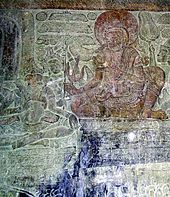
Vyasa narrating the Mahabharata to Ganesha, his scribe, Angkor Wat
The title "Leader of the group" (Sanskrit: ganapati) occurs twice in the Rig Veda, but in neither case does it refer to the modern Ganesha. The term appears in RV 2.23.1 as a title for Brahmanaspati, according to commentators.[157] While this verse doubtless refers to Brahmanaspati, it was later adopted for worship of Ganesha and is still used today.[158] In rejecting any claim that this passage is evidence of Ganesha in the Rig Veda, Ludo Rocher says that it "clearly refers to Bṛhaspati—who is the deity of the hymn—and Bṛhaspati only".[159] Equally clearly, the second passage (RV 10.112.9) refers to Indra,[160] who is given the epithet 'ganapati', translated "Lord of the companies (of the Maruts)."[161] However, Rocher notes that the more recent Ganapatya literature often quotes the Rigvedic verses to give Vedic respectability to Ganesha .[162]
Two verses in texts belonging to Black Yajurveda, Maitrayaniya Saṃhita (2.9.1)[163] and Taittiriya aranyaka (10.1),[164] appeal to a deity as "the tusked one" (Dantiḥ), "elephant-faced" (Hastimukha), and "with a curved trunk" (Vakratunḍa). These names are suggestive of Ganesha, and the 14th century commentator Sayana explicitly establishes this identification.[165] The description of Dantin, possessing a twisted trunk (vakratunḍa) and holding a corn-sheaf, a sugar cane, and a club,[166] is so characteristic of the Puranic Ganapati that Heras says "we cannot resist to accept his full identification with this Vedic Dantin".[167] However, Krishan considers these hymns to be post-Vedic additions.[168] Thapan reports that these passages are "generally considered to have been interpolated". Dhavalikar says, "the references to the elephant-headed deity in the Maitrayani Saṃhita have been proven to be very late interpolations, and thus are not very helpful for determining the early formation of the deity".[169]
Ganesha does not appear in Indian epic literature that is dated to the Vedic period. A late interpolation to the epic poem Mahabharata says that the sage Vyasa (Vyasa) asked Ganesha to serve as his scribe to transcribe the poem as he dictated it to him. Ganesha agreed but only on condition that Vyasa recite the poem uninterrupted, that is, without pausing. The sage agreed, but found that to get any rest he needed to recite very complex passages so Ganesha would have to ask for clarifications. The story is not accepted as part of the original text by the editors of the critical edition of the Mahabharata,[170] in which the twenty-line story is relegated to a footnote in an appendix.[171] The story of Ganesha acting as the scribe occurs in 37 of the 59 manuscripts consulted during preparation of the critical edition.[172] Ganesha's association with mental agility and learning is one reason he is shown as scribe for Vyasa's dictation of the Mahabharata in this interpolation.[173] Richard L. Brown dates the story to the 8th century, and Moriz Winternitz concludes that it was known as early as c. 900, but it was not added to the Mahabharata some 150 years later. Winternitz also notes that a distinctive feature in South Indian manuscripts of the Mahabharata is their omission of this Ganesha legend.[174] The term vinayaka is found in some recensions of the Santiparva and AnuSasanaparva that are regarded as interpolations.[175] A reference to Vighnakartṛinam ("Creator of Obstacles") in Vanaparva is also believed to be an interpolation and does not appear in the critical edition.[176]
Puranic period
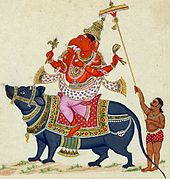
Tanjore-style painting of Ganesha
Stories about Ganesha often occur in the Puranic corpus. Brown notes while the Puranas "defy precise chronological ordering", the more detailed narratives of Ganesha's life are in the late texts, c. 600–1300.[177] Yuvraj Krishan says that the Puranic myths about the birth of Ganesha and how he acquired an elephant's head are in the later Puranas, which were composed from c. 600 onwards. He elaborates on the matter to say that references to Ganesha in the earlier Puranas, such as the Vayu and Brahmanda Puranas, are later interpolations made during the 7th to 10th centuries.[178]
In his survey of Ganesha's rise to prominence in Sanskrit literature, Ludo Rocher notes that:[179]
Above all, one cannot help being struck by the fact that the numerous stories surrounding GaneSa concentrate on an unexpectedly limited number of incidents. These incidents are mainly three: his birth and parenthood, his elephant head, and his single tusk. Other incidents are touched on in the texts, but to a far lesser extent.
Ganesha's rise to prominence was codified in the 9th century, when he was formally included as one of the five primary deities of Smartism. The 9th-century philosopher Saṅkaracarya popularized the "worship of the five forms" (pañcayatana pūja) system among orthodox Brahmins of the Smarta tradition.[180] This worship practice invokes the five deities Ganesha, Vishnu, Shiva, Devi, and Sūrya.[181] Saṅkaracarya instituted the tradition primarily to unite the principal deities of these five major sects on an equal status. This formalized the role of Ganesha as a complementary deity.
Once Ganesha was accepted as one of the five principal deities of Brahmanism, some Brahmins (Brahmanas) chose to worship Ganesha as their principal deity. They developed the Ganapatya tradition, as seen in the Ganesha Purana and the Mudgala Purana.[182]
The date of composition for the Ganesha Purana and the Mudgala Purana—and their dating relative to one another—has sparked academic debate. Both works were developed over time and contain age-layered strata. Anita Thapan reviews comments about dating and provides her own judgement. "It seems likely that the core of the Ganesha Purana appeared around the twelfth and thirteenth centuries", she says, "but was later interpolated."[183] Lawrence W. Preston considers the most reasonable date for the Ganesha Purana to be between 1100 and 1400, which coincides with the apparent age of the sacred sites mentioned by the text.[184]
R.C. Hazra suggests that the Mudgala Purana is older than the Ganesha Purana, which he dates between 1100 and 1400.[185] However, Phyllis Granoff finds problems with this relative dating and concludes that the Mudgala Purana was the last of the philosophical texts concerned with Ganesha. She bases her reasoning on the fact that, among other internal evidence, the Mudgala Purana specifically mentions the Ganesha Purana as one of the four Puranas (the Brahma, the Brahmanda, the Ganesha, and the Mudgala Puranas) which deal at length with Ganesha.[186] While the kernel of the text must be old, it was interpolated until the 17th and 18th centuries as the worship of Ganapati became more important in certain regions.[187] Another highly regarded scripture, the Ganapati Atharvashirsa, was probably composed during the 16th or 17th centuries.[188]
Beyond India and Hinduism
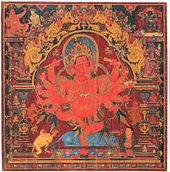
"Dancing Ganesh. Central Tibet. Early fifteenth century. Colours on cotton. height: 68 centimetres". [189] This form is also known as Maharakta ("The Great Red One").[190]
In 1993, a metal plate depiction of Ganesha had been discovered, in Iran, dating back to 1,200 BCE.[191]
Commercial and cultural contacts extended India's influence in western and southeast Asia. Ganesha is one of a number of Hindu deities who reached foreign lands as a result.[192]
Ganesha was particularly worshipped by traders and merchants, who went out of India for commercial ventures.[193] From approximately the 10th century onwards, new networks of exchange developed including the formation of trade guilds and a resurgence of money circulation. During this time, Ganesha became the principal deity associated with traders.[194] The earliest inscription invoking Ganesha before any other deity is associated with the merchant community.[195]
Hindus migrated to Maritime Southeast Asia and took their culture, including Ganesha, with them.[196] Statues of Ganesha are found throughout the region, often beside Shiva sanctuaries. The forms of Ganesha found in Hindu art of Java, Bali, and Borneo show specific regional influences.[197] The spread of Hindu culture to southeast Asia established Ganesha in modified forms in Burma, Cambodia, and Thailand. In Indochina, Hinduism and Buddhism were practiced side by side, and mutual influences can be seen in the iconography of Ganesha in the region.[198] In Thailand, Cambodia, and among the Hindu classes of the Chams in Vietnam, Ganesha was mainly thought of as a remover of obstacles.[199] Today in Buddhist Thailand, Ganesha is regarded as a remover of obstacles, the god of success.[199]
Before the arrival of Islam, Afghanistan had close cultural ties with India, and the adoration of both Hindu and Buddhist deities was practiced. Examples of sculptures from the 5th to the 7th centuries have survived, suggesting that the worship of Ganesha was then in vogue in the region.[200]
Ganesha appears in Mahayana Buddhism, not only in the form of the Buddhist god Vinayaka, but also as a Hindu demon form with the same name.[201] His image appears in Buddhist sculptures during the late Gupta period.[202] As the Buddhist god Vinayaka, he is often shown dancing. This form, called Nṛtta Ganapati, was popular in northern India, later adopted in Nepal, and then in Tibet.[203] In Nepal, the Hindu form of Ganesha, known as Heramba, is popular; he has five heads and rides a lion.[204] Tibetan representations of Ganesha show ambivalent views of him.[205] A Tibetan rendering of Ganapati is tshogs bdag.[206] In one Tibetan form, he is shown being trodden under foot by Mahakala,(Shiva) a popular Tibetan deity.[207] Other depictions show him as the Destroyer of Obstacles, and sometimes dancing.[208] Ganesha appears in China and Japan in forms that show distinct regional character. In northern China, the earliest known stone statue of Ganesha carries an inscription dated to 531.[209] In Japan, where Ganesha is known as Kangiten, the Ganesha cult was first mentioned in 806.[210]
The canonical literature of Jainism does not mention the worship of Ganesha.[211] However, Ganesha is worshipped by most Jains, for whom he appears to have taken over certain functions of Kubera.[212] Jain connections with the trading community support the idea that Jainism took up Ganesha worship as a result of commercial connections.[213] The earliest known Jain Ganesha statue dates to about the 9th century.[214] A 15th-century Jain text lists procedures for the installation of Ganapati images.[211] Images of Ganesha appear in the Jain temples of Rajasthan and Gujarat.[215]
Notes
- ^ "Ganesha getting ready to throw his lotus. Basohli miniature, circa 1730. National Museum, New Delhi. In the Mudgalapurana (VII, 70), in order to kill the demon of egotism (Mamasura) who had attacked him, GaneSa Vighnaraja throws his lotus at him. Unable to bear the fragrance of the divine flower, the demon surrenders to GaneSha. " For quotation of description of the work, see: Martin-Dubost (1997), p. 73.
- ^ Rao, p. 1.
- ^
- Brown, p. 1. "GaneSa is often said to be the most worshipped god in India. "
- Getty, p. 1. "GaneSa, Lord of the Ganas, although among the latest deities to be admitted to the Brahmanic pantheon, was, and still is, the most universally adored of all the Hindu gods and his image is found in practically every part of India. "
- ^
- Rao, p. 1.
- Martin-Dubost, pp. 2–4.
- Brown, p. 1.
- ^
- Chapter XVII, "The Travels Abroad", in: Nagar (1992), pp. 175–187. For a review of Ganesha's geographic spread and popularity outside of India.
- Martin-Dubost, pp. 311–320.
- Thapan, p. 13.
- Pal, p. x.
- ^ Martin-Dubost, p. 2.
- ^ For Ganesha's role as an eliminator of obstacles, see commentary on Ganapati Upanishad, verse 12 in Saraswati 2004, p. 80
- ^ Heras 1972, p. 58
- ^ These ideas are so common that Courtright uses them in the title of his book, Ganesha: Lord of Obstacles, Lord of Beginnings.
^ Getty, p. 5.
- ^ Narain, A. K. "GaneSa: The Idea and the Icon" in Brown 1991, p. 27
- ^ For history of the development of the ganapatya and their relationship to the wide geographic dispersion of Ganesha worship, see: Chapter 6, "The Ganapatyas" in: Thapan (1997), pp. 176–213.
- ^ Courtright, pp. 212–213.
- ^ For an English translation of Ganesha Purana 1.46, see: Bailey, pp. 258–269.
- ^
- Narain, A. K. "GaneSa: A Protohistory of the Idea and the Icon". Brown, pp. 21–22.
- Apte, p. 395.
- ^ For the derivation of the name and relationship with the ganas, see: Martin-Dubost. p. 2.
- ^ a b Apte, p. 395.
- ^ The word gana is interpreted in this metaphysical sense by Bhaskararaya in his commentary on the ganeSasahasranama. See in particular commentary on verse 6 including names GaneSvaraḥ and Ganakriḍaḥ in: Sastri Khiste 1991, pp. 7–8.
- ^
- Oka 1913, p. 8 for source text of AmarakoSa 1.38 as vinayako vighnarajadvaimaturaganadhipaḥ – apyekadantaherambalambodaragajananaḥ.
- Sastri 1978 for text of AmarakoSa versified as 1.1.38.
^ Y. Krishan (GaneSa:Unravelling an Enigma, p.6): "Parvati who created an image of GaneSa out of her bodily impurities but which became endowed with life after immersion in the sacred waters of the Ganga. Therefore he is said to have two mothers—Parvati and Ganga and hence called dvaimatura and also Gangeya."
- ^ Krishan p.6
- ^ a b Thapan, p. 20.
- ^ For the history of the ashtavinayaka sites and a description of pilgrimage practices related to them, see: Mate, pp. 1–25.
- ^ These ideas are so common that Courtright uses them in the title of his book, Ganesha: Lord of Obstacles, Lord of Beginnings. For the name Vighnesha, see: Courtright 1985, pp. 156, 213
- ^ a b For Krishan's views on Ganesha's dual nature see his quote: "GaneSa has a dual nature; as Vinayaka, as a gramadevata, he is vighnakarta, and as GaneSa he is vighnaharta, a pauranic devata." Krishan, p. viii.
- ^ Martin-Dubost, p. 367.
- ^ Narain, A. K. "GaneSa: The Idea and the Icon". Brown, p. 25.
- ^ Thapan, p. 62.
- ^ Myanmar-English Dictionary, Yangon: Dunwoody Press, 1993, ISBN 1-881265-47-1, retrieved 2010-09-20
^ Pal, p. ix.
- ^
- Martin-Dubost, for a comprehensive review of iconography abundantly illustrated with pictures.
- Chapter X, "Development of the Iconography of GaneSa", in: Krishan 1999, pp. 87–100, for a survey of iconography with emphasis on developmental themes, well-illustrated with plates.
- Pal, for a richly illustrated collection of studies on specific aspects of Ganesha with a focus on art and iconography.
- ^ Brown, p. 175.
- ^ Martin-Dubost, p. 213. In the upper right corner, the statue is dated as (973–1200).
- ^ Pal, p. vi. The picture on this page depicts a stone statue in the Los Angeles County Museum of Art that is dated as c. 12th century. Pal shows an example of this form dated c. 13th century on p. viii.
- ^ Brown, p. 176.
- ^ See photograph 2, "Large Ganesh", in: Pal, p. 16.
- ^
- Martin-Dubost, pp. 197–198.
- photograph 9, "Ganesh images being taken for immersion", in: Pal, pp. 22–23. For an example of a large image of this type being carried in a festival procession.
- Pal, p. 25, For two similar statues about to be immersed.
- ^
- Pal, pp. 41–64. For many examples of Ganesha dancing.
- Brown, p. 183. For popularity of the dancing form.
- ^ Four-armed GaneSa. Miniature of Nurpur school, circa 1810. Museum of Chandigarh. For this image see: Martin-Dubost (1997), p. 64, which describes it as follows: "On a terrace leaning against a thick white bolster, GaneSa is seated on a bed of pink lotus petals arranged on a low seat to the back of which is fixed a parasol. The elephant-faced god, with his body entirely red, is dressed in a yellow dhoti and a yellow scarf fringed with blue. Two white mice decorated with a pretty golden necklace salute GaneSa by joining their tiny feet together. GaneSa counts on his rosary in his lower right hand; his two upper hands brandish an axe and an elephant goad; his fourth hand holds the broken left tusk."
^ Nagar, p. 77.
- ^ Brown, p. 3.
- ^ Nagar, p. 78.
- ^ Brown, p. 76.
- ^ Brown, p. 77.
- ^ Brown, pp. 77–78.
- ^ Brown, pp. 76–77.
- ^ For creation of Ganesha from Shiva's laughter and subsequent curse by Shiva, see Varaha Purana 23.17 as cited in Brown: p. 77.
- ^ Getty, p. 1.
- ^ Heras, p. 29.
^ Granoff, Phyllis. "GaneSa as Metaphor". Brown, p. 90.
- ^ "Ganesha in Indian Plastic Art" and Passim. Nagar, p. 101.
- ^ Granoff, Phyllis. "GaneSa as Metaphor". Brown, p. 91.
- ^ For translation of udara as "belly" see: Apte, p. 268.
- ^
- Br. P. 2.3.42.34
- Thapan, p. 200, For a description of how a variant of this story is used in the Mudgala Purana 2.56.38–9
- ^ For an iconographic chart showing number of arms and attributes classified by source and named form, see: Nagar, pp. 191–195. Appendix I.
- ^ For history and prevalence of forms with various arms, and the four-armed form as one of the standard types, see: Krishan 1999, p. 89.
- ^
- Krishan 1999, p. 89, For two-armed forms as an earlier development than four-armed forms.
- Brown, p. 103. Maruti Nandan Tiwari and Kamal Giri say in "Images of GaneSa In Jainism" that the presence of only two arms on a Ganesha image points to an early date.
- ^ Martin-Dubost, p. 120.
- ^
- Martin-Dubost, p. 202, For an overview of snake images in Ganesha iconography.
- Krishan 1999, pp. 50–53, For an overview of snake images in Ganesha iconography.
^
- Martin-Dubost, p. 202.For the Ganesha Purana references for Vasuki around the neck and use of a serpent-throne.
- Krishan 1999, pp. 51–52. For the story of wrapping Vasuki around the neck and Sesha around the belly and for the name in his sahasranama as Sarpagraiveyakaṅgadaḥ ("Who has a serpent around his neck"), which refers to this standard iconographic element.
- ^
- Martin-Dubost, p. 202. For text of a stone inscription dated 1470 identifying Ganesha's sacred thread as the serpent Sesha.
- Nagar, p. 92. For the snake as a common type of yajñyopavita for Ganesha.
- ^
- Nagar, p. 81. For third eye or Shaiva tilaka with three horizontal lines.
- the dhyanam in: Sharma (1993 edition of Ganesha Purana) I.46.1. For Ganesa visualized as trinetraṁ (having three eyes).
- ^
- Nagar, p. 81. For citation to Ganesha Purana I.14.21–25 and For citation to Padma Purana as prescribing the crescent for decoration of the forehead of Ganesha
- Bailey (1995), pp. 198–199. For translation of Ganesha Purana I.14, which includes a meditation form with moon on forehead.
- ^
- Nagar, p. 81. For Bhalacandra as a distinct form worshipped.
- Sharma (1993 edition of Ganesha Purana) I.46.15. For the name Bhalacandra appearing in the Ganesha Sahasranama
- ^ a b Nagar, Preface.
- ^ "The Colors of Ganesha". Martin-Dubost, pp. 221–230.
- ^ Martin-Dubost, pp. 224–228
- ^ Martin-Dubost, p. 228.
- ^ "Ganesha". The Walters Art Museum.
^ Krishan, pp. 48, 89, 92.
- ^ Krishan, p. 49.
- ^
- Krishan, pp. 48–49.
- Bailey (1995), p. 348. For the Ganesha Purana story of MayūreSvara with the peacock mount (GP I.84.2–3)
- Maruti Nandan Tiwari and Kamal Giri, "Images of GaneSa In Jainism", in: Brown, pp.101–102.
- ^
- Nagar. Preface.
- Martin-Dubost, pp. 231–244.
- ^ See note on figure 43 in: Martin-Dubost, p. 144.
- ^ Citations to Matsya Purana 260.54, Brahmananda Purana Lalitamahatmya XXVII, and Ganesha Purana 2.134–136 are provided by: Martin-Dubost, p. 231.
- ^ Martin-Dubost, p. 232.
- ^ For Mūshakavahana see v. 6. For akhuketana see v. 67. In: GaneSasahasranamastotram: mūla evaṁ sribhaskararayakṛta ‘khadyota’ vartika sahita. (Pracya PrakaSana: Varanasi, 1991). Source text with a commentary by Bhaskararaya in Sanskrit.
- ^ For a review of different interpretations, and quotation, see: Grimes (1995), p. 86.
- ^ A Student's Guide to AS Religious Studies for the OCR Specification, by Michael Wilcockson, pg.117
^ Krishan pp. 49–50.
- ^
- Martin-Dubost, p. 231.
- Rocher, Ludo. "GaneSa's Rise to Prominence in Sanskrit Literature", in: Brown (1991), p. 73. For mention of the interpretation that "the rat is 'the animal that finds its way to every place,'"
- ^ "Lord of Obstacles", a common name, appears in the title of Courtright's GaneSa: Lord of Obstacles, Lord of Beginnings. For equivalent Sanskrit names VighneSvara and Vighnaraja, see: Courtright, p. 136.
- ^ Courtright, p. 136.
- ^ For Dhavilkar's views on Ganesha's shifting role, see Dhavalikar, M. K. "GaneSa: Myth and reality" in Brown 1991, p. 49
- ^ Brown, p. 6.
- ^ Nagar, p. 5.
- ^ Apte, p. 703.
- ^ Ganesha Purana I.46, v. 5 of the Ganesha Sahasranama section in GP-1993, Sharma edition. It appears in verse 10 of the version as given in the Bhaskararaya commentary.
- ^ Sharma edition, GP-1993 I.46, verses 204–206. The Bailey edition uses a variant text, and where Sharma reads Buddhipriya, Bailey translates Granter-of-lakhs.
^ Practical Sanskrit Dictionary By Arthur Anthony McDonell; p.187 (priya); Published 2004; Motilal Banarsidass Publ; ISBN 81-208-2000-2
- ^ Krishan 1999; pp. 60–70 discusses Ganesha as "Buddhi's Husband".
- ^ Grimes, p. 77.
- ^ Chinmayananda, p. 127. In Chinmayananda's numbering system, this is upamantra 8.
- ^ For examples of both, see: Grimes, pp. 79–80.
- ^ a b Tantra Unveiled: Seducing the Forces of Matter & Spirit By Rajmani Tigunait; Contributor Deborah Willoughby; Published 1999; Himalayan Institute Press; p. 83; ISBN 0-89389-158-4
- ^ Translation. Courtright, p. 253.
- ^ Chinmayananda, op. cit., p. 127. In Chinmayananda's numbering system this is part of upamantra 7. 'You have a permanent abode (in every being) at the place called "Muladhara"'.
- ^ This work is reproduced and described in Martin-Dubost (1997), p. 51, which describes it as follows: "This square shaped miniature shows us in a Himalayan landscape the god Siva sweetly pouring water from his kamanḍalu on the head of baby GaneSa. Seated comfortably on the meadow, Parvati balances with her left hand the baby GaneSa with four arms with a red body and naked, adorned only with jewels, tiny anklets and a golden chain around his stomach, a necklace of pearls, bracelets and armlets."
- ^
- Nagar, pp. 7–14. For a summary of Puranic variants of birth stories.
- Martin-Dubost, pp. 41–82. Chapter 2, "Stories of Birth According to the Puranas".
^ Shiva Purana IV. 17.47–57. Matsya Purana 154.547.
^ Varaha Purana 23.18–59.
^ For summary of Brahmavaivarta Purana, Ganesha Khanda, 10.8–37, see: Nagar, pp. 11–13.
^ For a summary of variant names for Skanda, see: Thapan, p. 300.
^ Khokar and Saraswati, p.4.
^ Brown, p. 4, 79.
^ Gupta, p. 38.
- ^ For a review, see: Cohen, Lawrence. "The Wives of GaneSa". Brown, pp. 115–140
^
- Getty 1936, p. 33. "According to ancient tradition, GaneSa was a Brahmacarin, that is, an unmarried deity; but legend gave him two consorts, personifications of Wisdom (Buddhi) and Success (Siddhi)."
- Krishan 1999, p. 63. "... in the smarta or orthodox traditional religious beliefs, GaneSa is a bachelor or brahmacari"
^ For discussion on celibacy of Ganesha, see: Cohen, Lawrence, "The Wives of GaneSa", in: Brown 1991, pp. 126–129.
- ^ For a review of associations with Buddhi, Siddhi, Riddhi, and other figures, and the statement "In short the spouses of GaneSa are the personifications of his powers, manifesting his functional features...", see: Krishan 1999, p. 62.
- ^ For single consort or a nameless daşi (servant), see: Cohen, Lawrence, "The Wives of GaneSa", in: Brown 1991, p. 115.
- ^ For associations with Sarda and Sarasvati and the identification of those goddesses with one another, see: Cohen, Lawrence, "The Wives of GaneSa", in: Brown 1991, pp. 131–132.
- ^ For associations with Lakshmi see: Cohen, Lawrence, "The Wives of GaneSa", in: Brown 1991, pp. 132–135.
- ^ For discussion of the Kala Bou, see: Cohen, Lawrence, "The Wives of GaneSa", in: Brown 1991, pp. 124–125.
- ^ For statement regarding sons, see: Cohen, Lawrence, "The Wives of GaneSa", in: Brown 1991, p. 130.
- ^
- Cohen, Lawrence. "The Wives of GaneSa". Brown, pp. 130.
- Thapan, pp. 15–16, 230, 239, 242, 251.
- ^ Krishan pp.1–3
- ^ K.N. Somayaji, Concept of Ganesha, p.1 as quoted in Krishan pp.2–3
- ^ Krishan p.38
- ^ For worship of Ganesha by "followers of all sects and denominations, Saivites, Vaisnavites, Buddhists and Jainas" see Krishan 1981–1982, p. 285
- ^ Grimes p.27
- ^ The term modaka applies to all regional varieties of cakes or sweets offered to Ganesha. Martin-Dubost, p. 204.
- ^ Martin-Dubost, p. 204.
- ^ Martin-Dubost, p. 369.
- ^ Martin-Dubost, pp. 95–99.
- ^ Thapan p.215
- ^ For the fourth waxing day in Magha being dedicated to Ganesa (GaneSa-caturthi) see: Bhattacharyya, B., "Festivals and Sacred Days", in: Bhattacharyya, volume IV, p. 483.
- ^ The Experience of Hinduism: Essays on Religion in Maharashtra; Edited By Eleanor Zelliot, Maxine Berntsen, pp.76–94 ("The Ganesh Festival in Maharashtra: Some Observations" by Paul B. Courtright); Published 1988; SUNY Press; ISBN 0-88706-664-X
- ^ Metcalf and Metcalf, p. 150.
- ^
- Brown (1992), p. 9.
- Thapan, p. 225. For Tilak's role in converting the private family festivals to a public event in support of Indian nationalism.
- ^
- Momin, A. R., The Legacy Of G. S. Ghurye: A Centennial Festschrift, p. 95.
- Brown (1991), p. 9. For Ganesha's appeal as "the god for Everyman" as a motivation for Tilak.
- ^ For Tilak as the first to use large public images in manḍapas (pavilions or tents) see: Thapan, p. 225.
- ^ For Ganesh Chaturthi as the most popular festival in Maharashtra, see: Thapan, p. 226.
- ^ "GaneSa in a Regional Setting". Courtright, pp. 202–247.
- ^ Krishan p.92
- ^ Brown p.3
- ^ Grimes, pp. 110–112
- ^ Krishan pp. 91–92
- ^ T.A.Gopinatha; Elements of Hindu Iconography, pp 47–48 as quoted in Krishan p.2
- ^ Krishan pp.147–158
- ^ "Ganesha Temples worldwide".
- ^ a b Narain, A. K. "GaneSa: A Protohistory of the Idea and the Icon", in: Brown, p. 19.
- ^ Nagar, p. 4.
- ^ Narain, A. K. "GaneSa: A Protohistory of the Idea and the Icon". Brown, pp. 19–20.
- ^ Courtright, pp. 10–11.
- ^ thapan, p.54
- ^ Thapan, p. 75.
- ^
- Passim. Thapan.
- Rocher, Ludo. "GaneSa's Rise to Prominence in Sanskrit Literature". Brown, pp. 70–72.
- ^ Aitareya Brahmana, I, 21.
- ^ Bhandarkar. Vaisnavism, Saivism and other Minor Sects. pp. 147–48.
- ^ Krishan, p. vii.
- ^ For a discussion of early depiction of elephant-headed figures in art, see Krishan 1981–1982, pp. 287–290 or Krishna 1985, pp. 31–32
- ^ Ellawala, p. 159.
- ^ "Loving GaneSa: Hinduism's Endearing Elephant-faced God", by Subramuniya, p. 268
- ^ "Dilip - Volume 2" P. 31
- ^ "The Art and Iconography of Vishnu-Narayana", p. 12, by Nanditha Krishna
- ^ Wilson, H. H. Ŗgveda Saṃhita. Sanskrit text, English translation, notes, and index of verses. Parimal Sanskrit Series No. 45. Volume II: Manḍalas 2, 3, 4, 5. Second Revised Edition; Edited and Revised by Ravi Prakash Arya and K. L. Joshi. (Parimal Publications: Delhi, 2001). ISBN 81-7110-140-9 (Vol. II); ISBN 81-7110-138-7 (Set). RV 2.23.1 (2222) gananaṃ tva ganapatiṃ havamahe kaviṃ kavinamupamaSravastamam | 2.23.1; "We invoke the Brahmanaspati, chief leader of the (heavenly) bands; a sage of sages."
- ^
- ^ Rocher, Ludo. "GaneSa's Rise to Prominence in Sanskrit Literature". Brown, p. 69. Bṛhaspati is a variant name for Brahamanaspati.
- ^ Rocher, Ludo. "GaneSa's Rise to Prominence in Sanskrit Literature". Brown, pp. 69–70.
- ^ Wilson, H. H. Ŗgveda Saṃhita. Sanskrit text, English translation, notes, and index of verses. Parimal Sanskrit Series No. 45. Volume IV: Manḍalas 9, 10. Second Revised Edition; Edited and Revised by Ravi Prakash Arya and K. L. Joshi. (Parimal Publications: Delhi, 2001). ISBN 81-7110-142-5 (Vol. IV); ISBN 81-7110-138-7 (Set). RV 10.112.9 (10092) ni shu sida ganapate ganeshu tvamahurvipratamaṃ kavinam; "Lord of the companies (of the Maruts), sit down among the companies (of the worshippers), they call you the most sage of sages".
- ^ For use of RV verses in recent Ganapatya literature, see Rocher, Ludo. "GaneSa's Rise to Prominence in Sanskrit Literature" in Brown 1991, p. 70
- ^ The verse : "tát karaţaya vidmahe | hastimukhaya dhîmahi | tán no dántî pracodáyat||"
- ^ The verse: " tát púrushâya vidmahe vakratunḍaya dhîmahi| tán no dántî pracodáyat||"
- ^ For text of Maitrayaniya Saṃhita 2.9.1 and Taittiriya aranyaka 10.1 and identification by Sayana in his commentary on the aranyaka, see: Rocher, Ludo, "GaneSa's Rise to Prominence in Sanskrit Literature" in Brown 1991, p. 70.
- ^ Taittiriya Aranyaka, X, 1, 5.
- ^ Heras, p. 28.
- ^
- ^
- Thapan, p. 101. For interpolation into the Maitrayaniya Saṃhita and Taittiriya aranyaka.
- Dhavalikar, M. K. "GaneSa: Myth and reality" in Brown 1991, pp. 56–57. For Dhavilkar's views on Ganesha's in early Literature.
- ^ Rocher, Ludo "Ganesa's Rise to Prominence in Sanskrit Literature". Brown, pp. 71–72.
- ^ Mahabharata Vol. 1 Part 2. Critical edition, p. 884.
- ^ For statement that "Fifty-nine manuscripts of the adiparvan were consulted for the reconstruction of the critical edition. The story of GaneSa acting as the scribe for writing the Mahabharata occurs in 37 manuscripts", see: Krishan 1999, p. 31, note 4.
- ^ Brown, p. 4.
- ^ Winternitz, Moriz. "GaneSa in the Mahabharata". Journal of the Royal Asiatic Society of Great Britain and Ireland (1898:382). Citation provided by Rocher, Ludo. "GaneSa's Rise to Prominence in Sanskrit Literature". Brown, p. 80.
- ^ For interpolations of the term vinayaka see: Krishan 1999, p. 29.
- ^ For reference to Vighnakartṛinam and translation as "Creator of Obstacles", see: Krishan 1999, p. 29.
- ^ Brown, p. 183.
- ^ Krishan, p. 103.
- ^ Rocher, Ludo. "GaneSa's Rise to Prominence in Sanskrit Literature". Brown, p. 73.
- ^
- Courtright, p. 163. For Dating of the pañcayatana pūja and its connection with Smarta Brahmins.
- Bhattacharyya, S., "Indian Hymnology", in: Bhattacharyya (1956), volume IV, p. 470. For the "five" divinities (pañcadevata) becoming "the major deities" in general, and their listing as Shiva, Shakti, Vishnu, Surya, and Ganesha.
- ^
- Grimes, p. 162.
- Pal, p. ix.
- ^ Thapan, pp. 196–197. Addresses the pañcayatana in the Smarta tradition and the relationship of the Ganesha Purana and the Mudgala Purana to it.
- ^ For a review of major differences of opinions between scholars on dating, see: Thapan, pp. 30–33.
- ^ Preston, Lawrence W., "Subregional Religious Centers in the History of Maharashtra: The Sites Sacred to GaneSa", in: N. K. Wagle, ed., Images of Maharashtra: A Regional Profile of India. p.103.
- ^ R.C. Hazra, "The GaneSa Purana", Journal of the Ganganatha Jha Research Institute (1951);79–99.
- ^ Phyllis Granoff, "GaneSa as Metaphor", in Brown, pp. 94–95, note 2.
- ^ Thapan, pp. 30–33.
- ^ Courtright, p. 252.
- ^ This work and its description are shown in Pal, p. 125.
- ^ For a representation of this form identified as Maharakta, see Pal, p. 130.
- ^ "Loving GaneSa: Hinduism's Endearing Elephant-faced God", by Subramuniya, p. 268
- ^ Nagar, p. 175.
- ^ Nagar, p. 174.
- ^ Thapan, p. 170.
- ^ Thapan, p. 152.
- ^ Getty, p. 55.
- ^ Getty, pp. 55–66.
- ^ Getty, p. 52.
- ^ a b Brown, p. 182.
^ * Nagar, p. 175. * Martin-Dubost, p. 311.
^ Getty, pp. 37–45.
^ Getty, p. 37.
^ Getty, p. 38.
^ Getty, p. 40.
^ Nagar, p. 185.
^ Wayman, Alex (2006). Chanting the Names of Manjushri. Motilal Banarsidass Publishers: p.76 . ISBN 81-208-1653-6
^
- Getty, p. 42
- Nagar, p. 185.
^ Nagar, pp. 185–186.
^ Martin-Dubost, p. 311.
- ^ Martin-Dubost, p. 313.
- ^ a b Krishan, p. 121.
- ^ Thapan, p. 157.
- ^ Thapan, pp. 151, 158, 162, 164, 253.
- ^ Krishan, p. 122.
- ^ Thapan, p. 158.
References
- Agrawala, Prithvi Kumar (1978), Goddess Vinayaki: The Female GaneSa, Indian Civilization Series, Varanasi: Prithivi Prakashan
- Apte, Vaman Shivram (1965), The Practical Sanskrit Dictionary, Delhi: Motilal Banarsidass Publishers, ISBN 81-208-0567-4 (fourth revised and enlarged edition).
- Avalon, Arthur (1933), Sarada Tilaka Tantram, Motilal Banarsidass Publishers, ISBN 81-208-1338-3 (1993 reprint edition).
- Bailey, Greg (1995), GaneSapurana: Introduction, translation, notes and index, Harrassowitz, ISBN 3-447-03647-8
- Bhattacharyya (Editor), Haridas (1956), The Cultural Heritage of India, Calcutta: The Ramakrishna Mission Institute of Culture Four volumes.
- Brown, Robert (1991), Ganesh: Studies of an Asian God, Albany: State University of New York, ISBN 0-7914-0657-1
- Chinmayananda, Swami (1987), Glory of Ganesha, Bombay: Central Chinmaya Mission Trust
- Courtright, Paul B. (1985), GaneSa: Lord of Obstacles, Lord of Beginnings, New York: Oxford University Press, ISBN 0-19-505742-2
- Danielou, Alain (1954), The meaning of Ganapati, Madras: The Adyar Library bulletin
- Doniger, Wendy (1996), Merriam-Webster's Encyclopedia of World Religions, Merriam-Webster, ISBN 0-87779-044-2
- Ellawala, H (1969), Social History of Early Ceylon, Colombo: Department of Cultural Affairs .
- Flood, Gavin (1996), An Introduction to Hinduism, Cambridge: Cambridge University Press, ISBN 0-521-43878-0
- Getty, Alice (1936), GaneSa: A Monograph on the Elephant-Faced God (1992 reprint ed.), Oxford: Clarendon Press, ISBN 81-215-0377-X
- Grimes, John A. (1995), Ganapati: Song of the Self, SUNY Series in Religious Studies, Albany: State University of New York Press, ISBN 0-7914-2440-5
- Gupta, Shakti M. (1988), Karttikeya: The Son of Shiva, Bombay: Somaiya Publications Pvt. Ltd., ISBN 81-7039-186-5
- Heras, H. (1972), The Problem of Ganapati, Delhi: Indological Book House
- Jansen, Eva Rudy (1993), The Book of Hindu Imagery, Havelte, Holland: Binkey Kok Publications BV, ISBN 90-74597-07-6
- Khokar, Ashish; S. Saraswati (2005), Ganesha-Karttikeya, New Delhi: Rupa and Co, ISBN 81-291-0776-7
- Krishan, Yuvraj (1981–1982), "The Origins of GaneSa", Artibus Asiae (Artibus Asiae Publishers) 43 (4): 285–301, doi:10.2307/3249845, JSTOR 3249845
- Krishan, Yuvraj (1999), GaneSa: Unravelling An Enigma, Delhi: Motilal Banarsidass Publishers, ISBN 81-208-1413-4
- Krishna, Murthy, K. (1985), Mythical Animals in Indian Art, New Delhi: Abhinav Publications, ISBN 0-391-03287-9
- Macdonell, Arthur Anthony (1996), A Practical Sanskrit Dictionary, Munshiram Monoharlal Publishers, ISBN 81-215-0715-4
- Martin-Dubost, Paul (1997), GaneSa: The Enchanter of the Three Worlds, Mumbai: Project for Indian Cultural Studies, ISBN 81-900184-3-4
- Mate, M. S. (1988), Temples and Legends of Maharashtra, Bombay: Bharatiya Vidya Bhavan [dead link]
- Metcalf, Thomas R.; Metcalf, Barbara Daly, A Concise History of India, ISBN 0-521-63027-4
- Nagar, Shanti Lal (1992), The Cult of Vinayaka, New Delhi: Intellectual Publishing House, ISBN 81-7076-043-9
- Oka, Krishnaji Govind (1913), The NamalinganuSasana (Amarakosha) of Amarasimha: with the Commentary (Amarakoshodghatana) of Kshirasvamin, Poona: Law Printing Press, retrieved 2007-09-14 .
- Pal, Pratapaditya (1995), Ganesh: The Benevolent, Marg Publications, ISBN 81-85026-31-9
- Ramachandra Rao, S. K. (1992), The Compendium on GaneSa, Delhi: Sri Satguru Publications, ISBN 81-7030-828-3
- Saraswati, Swami Tattvavidananda (2004), Ganapati Upanishad, Delhi: D. K. Printworld Ltd., ISBN 81-246-0265-4
- Sastri Khiste, Batukanatha (1991), GaneSasahasranamastotram: mūla evaṁ sribhaskararayakṛta ‘khadyota’ vartika sahita, Varanasi: Pracya PrakaSana . Source text with a commentary by Bhaskararaya in Sanskrit.
- Sastri, Hargovinda (1978), AmarKosha with Hindi commentary, Varanasi: Chowkhamba Sanskrit Series Office
- Thapan, Anita Raina (1997), Understanding Ganapati: Insights into the Dynamics of a Cult, New Delhi: Manohar Publishers, ISBN 81-7304-195-4
- Wilson, H. H. (1990), Rgveda-Samhita, Text in Devanagari, English translation Notes and indices by H. H. Wilson, Ed. W.F. Webster, New Delhi: Nag Publishers,11A/U.A. Jawaharnagar
| Data Arrangement, Technical Arrangement & Graphics |
|---|
| ♦ Guruji Murugan Chillayah - Silambam Asia |
| |
| References ( Ganesha ) |
|---|
| ♦ no_data |
| ♦ no_data |
|

